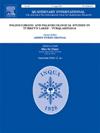Snapshots from the past: Biodiversity of the Vesuvian area before AD 79 from new archaeopalynological studies
IF 1.9
3区 地球科学
Q3 GEOGRAPHY, PHYSICAL
引用次数: 0
Abstract
The Vesuvian area is rich in well-studied archaeological sites, in which the exceptional preservation of plant remains has led to an in-depth botanical reconstruction of aspects related to diet, rituals and elements of the local urban landscape. Pollen analyses have been mainly focused on the reconstruction of gardens, providing direct evidence of floristic composition, plant selection and seasonality. With a biological approach, the present study aims to contribute to a broader understanding of the plant diversity that characterised the Vesuvian area through the study of 1st century AD Vesuvian sites, i.e. Stabiae and Pompeii. Forty pollen samples were studied from three sites in the Vesuvian area: the two multipoint sites of Stabiae and Pompeii and the Civita Giuliana site close to Pompeii. At Stabiae (nowadays Castellammare di Stabia), pollen investigation conducted in two villae (“Villa Arianna” and “Villa San Marco”) provided important information to reconstruct the plant landscape before the catastrophic eruption of AD 79. In Pompeii, two plaster samples from two houses (“Casa del Menandro” and “Casa del Centenario”) were studied and, in the nearby Civita Giuliana, samples are from an agricultural area. Among the main features common to the studied contexts, it is noteworthy the presence of a large amount of pollen from fruit trees (Juglans, Olea, Vitis, Castanea) and evidence of ornamental plants. These elements characterised the rich cultural landscape of the area. Despite some caution due to pollen preservation issues, when a high level of identification is achieved, palynology proves to be a reliable tool for the knowledge of biodiversity and landscape patterns in vulnerable areas exposed to natural events.
从过去的快照:从新的考古物学研究来看公元79年以前维苏威地区的生物多样性
维苏威火山地区有丰富的考古遗址,在那里,植物遗骸的特殊保存导致了与饮食、仪式和当地城市景观元素相关的方面的深入植物重建。花粉分析主要集中在园林重建上,为植物区系组成、植物选择和季节性提供直接证据。本研究采用生物学方法,旨在通过对公元1世纪维苏威遗址(即Stabiae和Pompeii)的研究,对维苏威地区的植物多样性有更广泛的了解。研究了维苏威地区三个遗址的40个花粉样本:Stabiae和Pompeii的两个多点遗址和庞贝附近的Civita Giuliana遗址。在Stabiae(现在的Castellammare di Stabia),在两个村庄(“Villa Arianna”和“Villa San Marco”)进行的花粉调查为重建公元79年灾难性火山爆发前的植物景观提供了重要信息。在庞贝,研究了来自两座房屋(“Casa del Menandro”和“Casa del Centenario”)的两个石膏样本,在附近的奇维塔朱利亚纳,样本来自一个农业区。在研究环境的主要特征中,值得注意的是存在大量来自果树(核桃、油橄榄、葡萄、Castanea)的花粉和观赏植物的证据。这些元素构成了该地区丰富的文化景观。尽管由于花粉保存问题而存在一些谨慎,但当获得高水平的鉴定时,孢粉学被证明是了解自然事件脆弱地区生物多样性和景观格局的可靠工具。
本文章由计算机程序翻译,如有差异,请以英文原文为准。
求助全文
约1分钟内获得全文
求助全文
来源期刊

Quaternary International
地学-地球科学综合
CiteScore
5.60
自引率
4.50%
发文量
336
审稿时长
3 months
期刊介绍:
Quaternary International is the official journal of the International Union for Quaternary Research. The objectives are to publish a high quality scientific journal under the auspices of the premier Quaternary association that reflects the interdisciplinary nature of INQUA and records recent advances in Quaternary science that appeal to a wide audience.
This series will encompass all the full spectrum of the physical and natural sciences that are commonly employed in solving Quaternary problems. The policy is to publish peer refereed collected research papers from symposia, workshops and meetings sponsored by INQUA. In addition, other organizations may request publication of their collected works pertaining to the Quaternary.
 求助内容:
求助内容: 应助结果提醒方式:
应助结果提醒方式:


